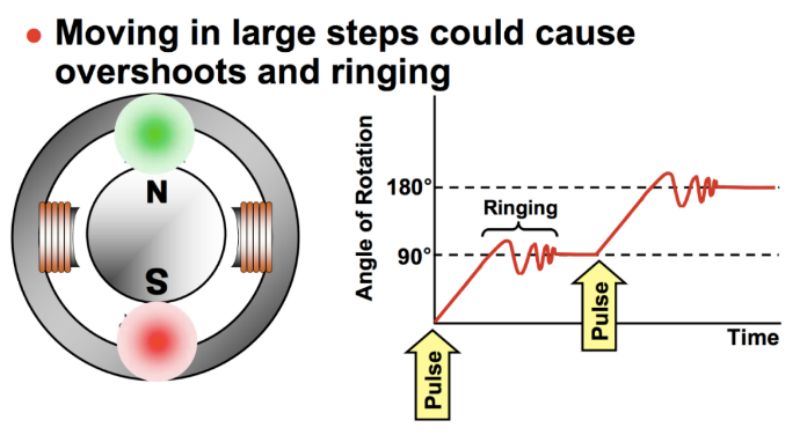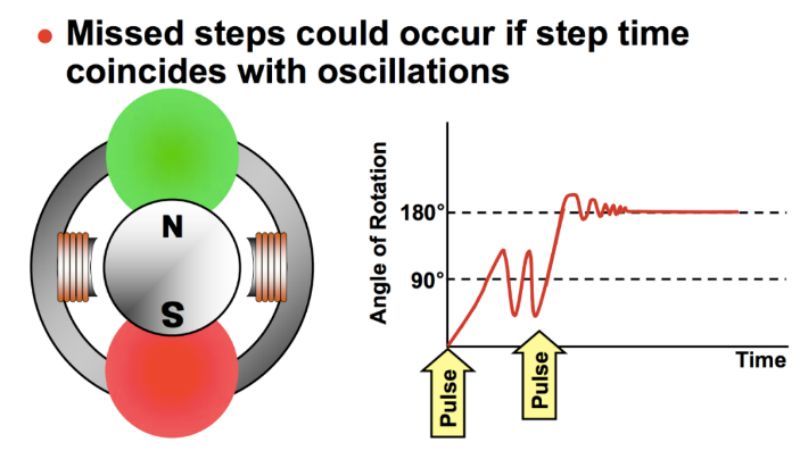In normal operation, the stepper motor moves one step angle, i.e. one step forward, for each control pulse received. If control pulses are input continuously, the motor rotates continuously accordingly. Stepping motor out of step includes lost step and overstep. When the step is lost, the number of steps advanced by the rotor is less than the number of pulses; when the step is crossed, the number of steps advanced by the rotor is more than the number of pulses. The number of steps for one lost step and overstep is equal to an integer multiple of the number of running beats. A serious step loss will cause the rotor to stay in one position or vibrate around one position, and a serious step overstep will cause the motor to overshoot.
Loss of step cause and strategy
(1) The acceleration of the rotor is slower than the rotating magnetic field of the stepper motor
Explanation:
When the acceleration of the rotor is slower than the rotating magnetic field of the stepper motor, i.e., lower than the phase change speed, the stepper motor generates out-of-step. This is due to insufficient power input to the motor and the synchronising torque generated in the stepper motor does not allow the rotor speed to follow the rotational speed of the stator magnetic field, thus causing the out-of-step. Since the dynamic output torque of a stepper motor decreases as the frequency of continuous operation rises, any operating frequency higher than that will produce a lost step. This loss of step indicates that the stepper motor does not have enough torque and does not have enough dragging capacity.
Solution:
a. Make the electromagnetic torque generated by the stepping motor itself increase. This can be in the rated current range to increase the driving current; in the high-frequency range of torque is not enough, you can improve the driving voltage of the driving circuit; change to use a large torque stepping motor, etc. b, so that the stepping motor needs to overcome the torque is reduced. This can be done by appropriately reducing the motor operating frequency in order to increase the output torque of the motor; setting a longer acceleration time so that the rotor obtains sufficient energy.
(2) The average speed of the rotor is higher than the average rotation speed of the stator magnetic field
Explanation:
The average speed of the rotor is higher than the average rotational speed of the stator magnetic field, when the stator is energised and excited for a longer period of time than the time required for the rotor to step further, then the rotor acquires too much energy during the stepping process, which makes the output torque produced by the stepping motor increase, thus causing the motor to overstep. When the stepping motor is used to drive those mechanisms that make the load move up and down, it is more likely to produce the phenomenon of overstepping, which is due to the fact that the torque required by the motor decreases when the load moves downward.
Solution:
Reduce the drive current of the stepping motor in order to reduce the output torque of the stepping motor.
(3) Inertia of the stepping motor and the load it carries
Explanation:
Due to the inertia of the stepping motor itself and the load it carries, the motor cannot be started and stopped immediately during operation, but a lost step occurs during starting and an overstep occurs during stopping.
Solution:
Through an acceleration and deceleration process, i.e. starting at a lower speed, then gradually accelerating to a certain speed operation, and then gradually decelerating until stopping. Reasonable and smooth acceleration and deceleration control is the key to ensure the reliable, efficient and accurate operation of the stepper drive system.
(4) Resonance of stepping motor
Explanation:
Resonance is also a cause of out-of-step. When the stepper motor is in continuous operation, if the frequency of the control pulse is equal to the intrinsic frequency of the stepper motor, resonance will occur. Within one control pulse period, the vibration is not sufficiently attenuated, and the next pulse comes, thus the dynamic error near the resonance frequency is the largest and will cause the stepper motor to lose step.
Solution:
Appropriately reduce the drive current of the stepper motor; use subdivision drive method; use damping methods, including mechanical damping method. All of the above methods can effectively eliminate motor oscillation and avoid the phenomenon of out-of-step.
(5) Loss of pulse when changing direction
Explanation:
It is shown that it is accurate in any direction, but it accumulates deviation as soon as the direction is changed, and the more times it is changed, the more it is deviated.
Solution:
General stepper drive on the direction and pulse signals have certain requirements, such as: the direction of the signal in the first pulse along the rising edge or falling edge (different drive requirements are not the same) before the arrival of a few microseconds to be determined, otherwise there will be a pulse of the angle of operation and the actual need to turn to the opposite direction, and finally the failure phenomenon is manifested in the more you go more biased, the smaller the breakdown is more pronounced, the solution is mainly used in the software to change the logic of sending a pulse The solution is mainly to use software to change the logic of sending pulses or add a delay.
(6) Software defects
Explanation:
Control procedures lead to lost step is not uncommon, need to check the control programme is not a problem.
Solution:
Can not find the cause of the problem for a while, there are also engineers will let the stepper motor run for a period of time to re-find the origin homing.
Post time: Mar-19-2024


